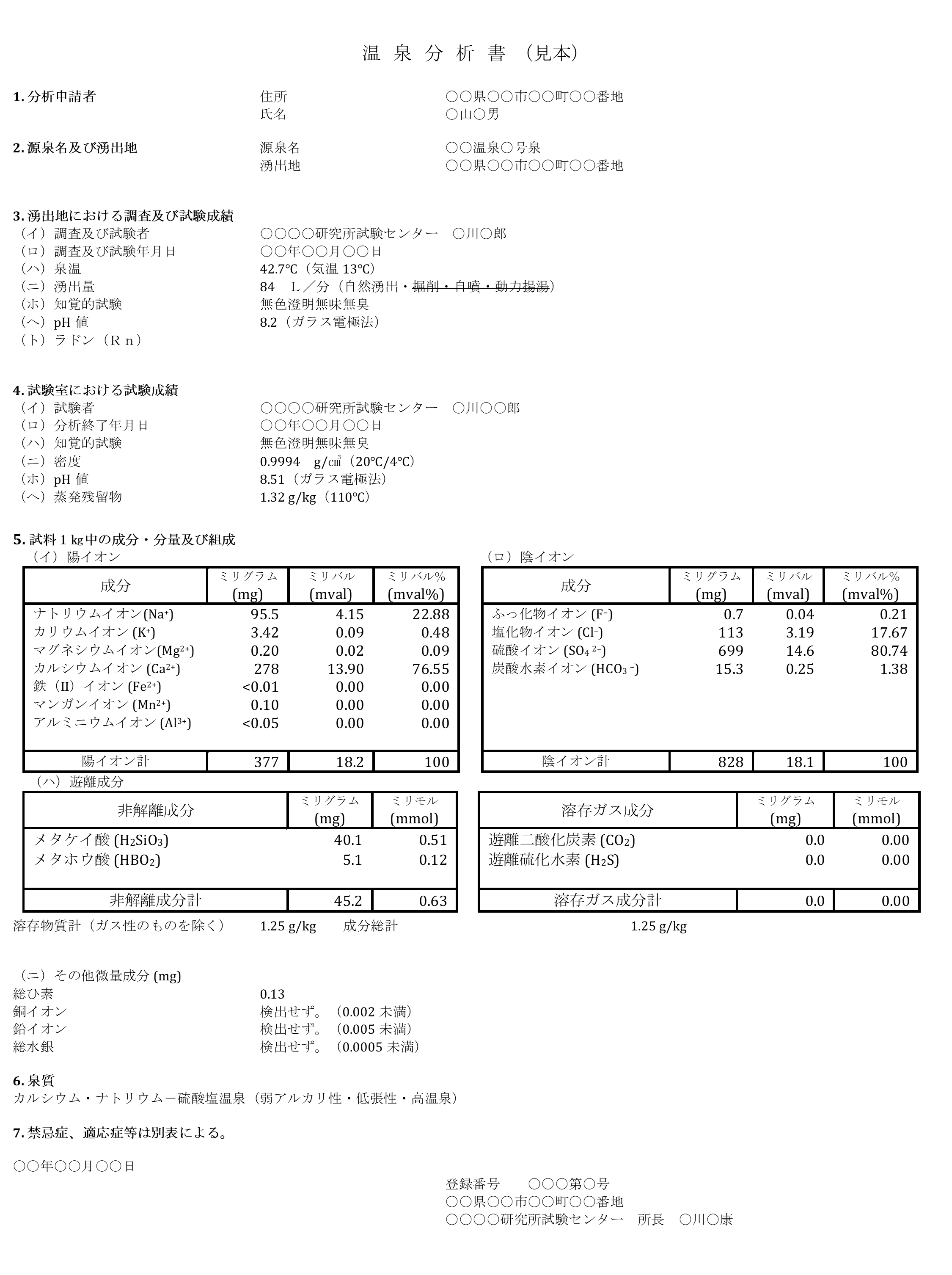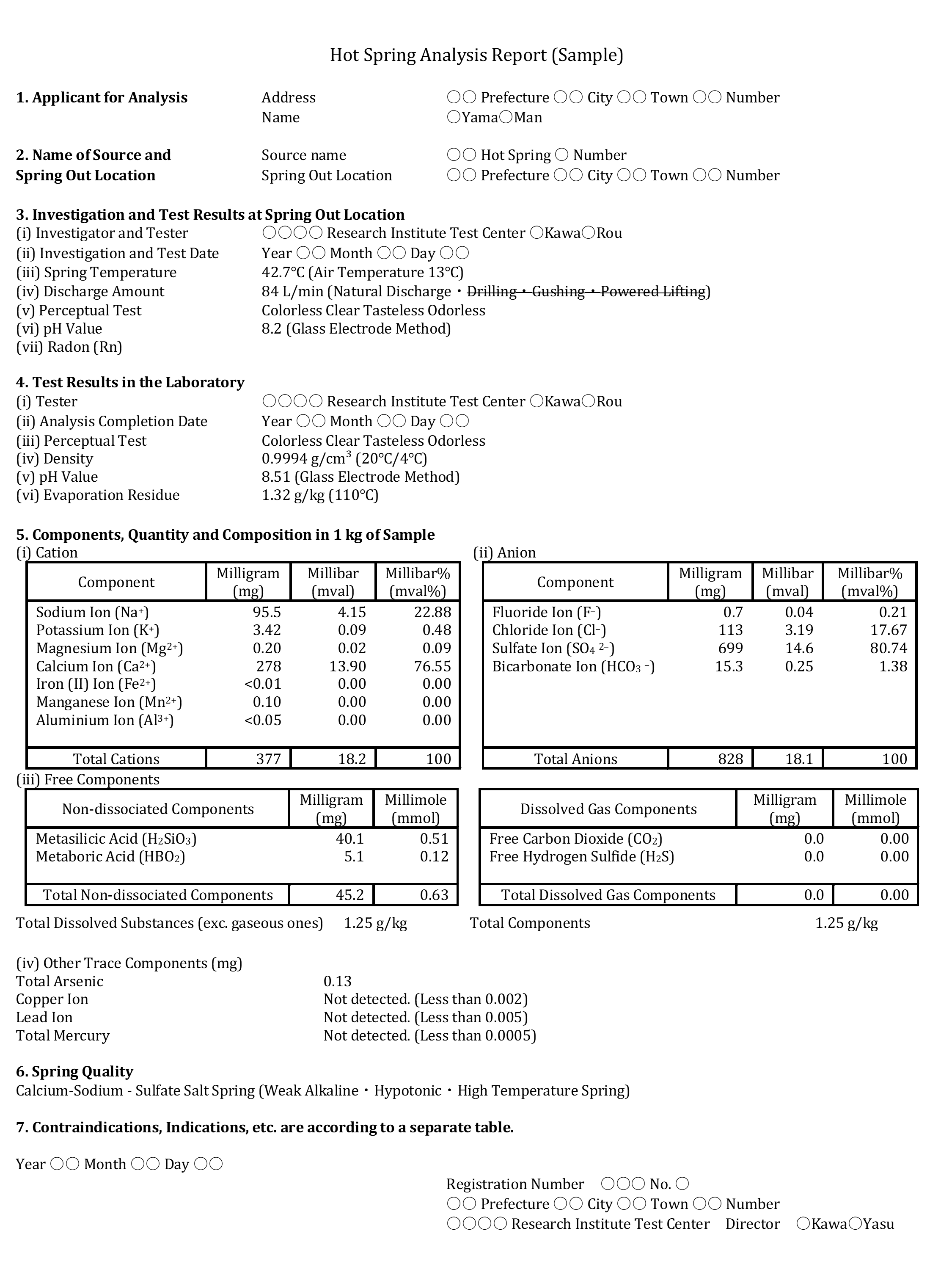water quality
Characteristics of Onsen Water
Onsen Water Colors
- White
- Blue
- Red
- Green
- Brown
- Others
Milky White, Grayish White, Yellowish White

- Characteristics: These hot springs are popular due to their turbid appearance, often resembling colors like milky white or yellowish white. The turbidity is a result of sulfur compounds formed when hydrogen sulfide in the sulfur spring undergoes oxidation. When springs contain mud or mucilaginous substances, they can also appear milky white to grayish white.
- Examples: Hokkaido’s Niseko Hot Spring Village, Aomori’s Sukayu Hot Spring, Akita’s Nyuto Hot Spring Village (e.g. Tsurunoyu; picture), Fukushima’s Takayu Hot Spring, Tochigi’s Nasu Yumoto Hot Spring, parts of Gunma’s Manza Hot Spring & Kusatsu Hot Spring, Kanagawa’s Hakone Hot Spring Village, Nagano’s Shirahone Hot Spring, Oita’s Beppu Hot Spring Village.
Aqua, Bluish White

- Characteristics: Hot springs in this category vary from a clear blue to a light aqua. Their color is influenced by the presence of meta-silicic acid in high-temperature springs, and the hue can change due to light reflection. Some with a bluish-white hue can be turbid due to the interaction of sulfur compounds and light reflections.
- Examples: “Sea Hell” in Beppu Hot Spring Village (picture), other parts of Beppu Hot Spring Village like the Iron Wheel area.
Red, Reddish-Brown

- Charcteristics: Springs in the red series showcase colors ranging from a vibrant red to hues like reddish-brown and orange. This coloring arises when the iron content in the springs reacts with air, leading to oxidation. The resulting ferric hydroxide gives the springs their distinctive reddish hues.
- Examples: Arima Onsen in Hyogo (picture; Golden Spring), Blood Pond Hell in Beppu Hot Spring Village.
Green, Yellow-Green

- Characteristics: Springs in this category can display a spectrum of colors, from transparent clear green to yellow-green. Acidic iron springs typically exhibit a transparent pale green appearance. In contrast, sulfur springs that lean towards neutrality or alkalinity can sometimes possess a yellow-green hue.
- Examples: Kunimi Onsen in Iwate (picture Ishizuka Ryokan), Tsukioka Onsen in Niigata, Kawa Watari Onsen in Miyagi, Kuma no Yu Onsen in Nagano.
Dark Brown, Brownish

- Characteristics: These hot springs can range from a dark brown, resembling the color of cola or coffee, to a lighter shade of brown. The presence of organic substances, particularly humic acid and fulvic acid, influences this coloration. When springs contain a slight amount of iron, exposure to air and oxidation can also lead to a light brown hue.
- Examples: Tokachigawa Onsen in Hokkaido (picture), hot springs around Obihiro, hot springs within Tokyo’s 23 wards, flatland hot springs in Kanagawa, hot springs in the Kofu Basin.

- Characteristics: Springs in this category can exhibit a variety of colors, notably yellowish-brown, greenish-brown, and light yellow. The yellowish and greenish-brown hues are influenced by the combination of iron, sulfur, and other elements present in the water. Springs with a light yellow appearance often have sulfur content.
- Examples: Niseko Konbu Onsen in Hokkaido, Koganezaki Furofushi Onsen in Aomori (picture), the original hot spring of Shiobara Onsen Village in Tochigi, Nigorigo Onsen in Gifu.
Onsen Water Quality
| Spring Type | Standard | Characteristics | Example | Health (bathing) | Health (drinking) |
|---|---|---|---|---|---|
| Simple Springs | Dissolved ingredients =< 1000 mg/kg | Mild texture | Gero Onsen | Autonomic instability | |
| pH => 8.5 is "alkaline" * | Sweet | Kakeyu Onsen | Insomnia | ||
| Little Irritation to skin | Depression | ||||
| * Alkaline simple springs provides the "smooth" feeling when bathing | |||||
| Chloride Springs | Dissolved ingredients => 1000 mg/kg | Salty taste (when salts dominate) | Atami Onsen | Cuts, dry skin | Atrophic gastritis |
| Bitter taste (when high salinity / lots of magnesium | Katayamatsu Onsen | Peripheral circulation failure | Constipation | ||
| Excessive sensitivity to cold | |||||
| Various subtypes* | Depression | ||||
| * Depending on main ingredients can be classified as "sodium", "calcium", "magnesium" etc. - chloride spring. Major spring water type in Japan! | |||||
| Carbonated Springs | Dissolved ingredients => 1000 mg/kg | Calcium-bicarbonate springs may generate deposits and precipitates. | Kawatsu Onsen | Cuts | Gastroduodenal ulceration |
| Main ingredients: hydrogen carbonate ions | Otani Onsen | Peripheral circulation failure | Reflux esophagitis | ||
| Excessive sensitivity to cold | Impartial glucose tolerance (Diabetes) | ||||
| Various subtypes* | Depression | Hyperuricemia (gout) | |||
| * Depending on main ingredients can be classified as "sodium hydrogen", "calcium hydrogen", "magnesium hydrogen" etc. - carbonate spring. | |||||
| Sulphate Springs | Dissolved ingredients => 1000 mg/kg | Various subtypes* | Hoshi Onsen | Cuts, dry skin | Biliary dysfunction |
| Main ingredients: sulphate/sulfate anions | Amagiyugashima Onsen | Peripheral circulation failure | Dyslipidemia | ||
| Excessive sensitivity to cold | Constipation | ||||
| Depression | |||||
| * Depending on main ingredients can be classified as "sodium", "calcium", "magnesium" etc. - suflate spring. | |||||
| Carbon dioxide Springs | free carbonate (carbon dioxide) => 1000 mg/kg | Small bubbles of carbonic acid adhere to skin | Nagayu Onsen | Cuts | Gastrointestinal hypofunction |
| Main ingredients: free carbonates | Sense of "refreshment" | Kogane Onsen | Peripheral circulation failure | ||
| When drinking feels slightly carbonated | Excessive sensitivity to cold | ||||
| Comparatively rare type* | Autonomic instability | ||||
| * Seems that not too many of this type. Usually the temperatures are also lower compared to other onsen | |||||
| Ferrunbginous Springs | Total iron ion(Fre++ or Fe+++) => 20 mg/kg | Change color to "red" during exposure to air (oxidization) | Arima Onsen | Iron-deficiency anemia | |
| Main ingredients: iron ion * | |||||
| * Classified into bicarbonate type and sulfate type depending on the anions. | |||||
| Acidic Springs | hydrogen ions => 1 mg/kg | Sour taste | Tamagawa Onsen | Atopic dermatitis | |
| Sterilization effect | Sukawa Onsen | Plaque psoriasis | |||
| Can be found throughout Japan, though hardly in Europe | Impartial glucose tolerance (Diabetes) | ||||
| Epidermoid suppuration | |||||
| Lodine-containing Springs | iodide ions => 10 mg/kg | Mainly in non-volcanic onsen areas. | Aomori Onsen (Chiba Pref.) | Dyslipidemia | |
| Become yellow when left for awhile | Maenohara Onsen (Tokyo) | ||||
| Sulphate Springs | Total sulphur => 2 mg/kg | Characteristic smell of "rotten eggs" due to hydrogen sulfide | Nikko Yumoto Onsen | Atopic dermatitis | Impartial glucose tolerance (Diabetes) |
| Kowakudani Onsen (Hakone) | Plaque psoriasis | Dyslipidemia | |||
| Two main types * | Onsenkyo | Chronic eczema | |||
| Epidermolysis | |||||
| Peripheral circulation failure | |||||
| * sulfur type and hydrogren sulfide type | |||||
| Radioactive Springs | Contains Radon => 3 nanocuries (8.25 mache unit or more)/kg | Accordingly very small amounts of radioactivity have positive effect on the human bodies (SOURCE) | Misasa Onsen | Hyperuricemia (gout) | |
| Masutomi Onsen | Rheumatoid arthritis | ||||
| Ankylosing spondylitis | |||||
| etc.* | |||||
Rerefence for Reading Hot Spring (Onsen) Analysis Report
Every time you visit onsen, ryokan, hotel or any place that has hot spring bath, it also has the analysis report on some section of the wall. Usually this is placed in the changing room area. Might differ a little from place to place, but quite noticeble. Few things to note:
- Values on the report show them during the time of testing and do not quarantee they stay exactly the same (slight variations may occur).
- Various info include: water temperature (source and in bath), water gushing amount, spring quality, contraindications and indications, and precautions.


Talk to us
Have any questions, suggestions, or would like to collaborate?
Give us a shout and we’ll get back to you as soon as possible!